Abstract
Recently, long tunnels are becoming more prevalent in Korea, and exits are added at certain sections of the tunnels. Thus, a navigation system should correctly guide the user toward the exit; however, adequate guidance is not delivered because the global navigation satellite system (GNSS) signal is not received inside a tunnel. Therefore, we present an accurate position estimation system using a magnetic field for vehicles passing through a tunnel. The position can be accurately estimated using the magnetic sensor of a smartphone with an appropriate attitude estimation and magnetic sensor calibration. Position estimation was realized by attaching the smartphone on the dashboard during navigation and calibrating the sensors using position information from the GNSS and magnetic field database before entering the tunnel. This study used magnetic field sequence data to estimate vehicle positions inside a tunnel. Furthermore, subsequence dynamic time warping was applied to compare the magnetic field data stored in the buffer with the magnetic field database, and the feasibility and performance of the proposed system was reviewed through an experiment in an actual tunnel. The analysis of the position estimation results confirmed that the proposed system could appropriately deliver tunnel navigation.
1. Introduction
Vehicle navigation services are essential for drivers and can be used with smartphones, regardless of time, weather, or location (under coverage). In general, most of these services are available for free and operate based on a global navigation satellite system (GNSS) [1], through which users can accurately determine their current location in real time. GNSS can accurately estimate the user position for a clear line of sight between the user and satellite. For instance, numerous multipaths occur in an urban area with several tall buildings, and the GNSS performance is degraded. Similarly, accurate positioning cannot be determined in places where GNSS signals are not received such as indoors or tunnels [2]. As the current navigation system relies on only the GNSS, the navigation service is restricted in places with inferior GNSS signal quality.
Seamless navigation is an aspect required in future navigation systems. Currently, navigation applications in smartphones do not provide seamless navigation as only the GNSS is utilized. For instance, navigation ceases when a vehicle enters an underground parking lot from outdoors [3], especially in airports, large shopping malls, and hospitals, which usually have large underground parking lots, and first-time visitors face difficulties in locating their position. If the vehicle position in the underground parking lot can be estimated using other infrastructure, users can experience a new navigation service. Moreover, the current navigation system needs to be supplemented in the tunnel environment, as it provides position information inside the tunnel by simply calculating the position using the initial entry velocity of the vehicle. It is thought that this situation may not cause much inconvenience to the driver, but in fact, it is not. The positioning error accumulates as the vehicle velocity alters inside the tunnel. Even if the vehicle stops due to traffic jams or accidents inside the tunnel, the navigation screen simply indicates that the vehicle continues to move. In addition, navigation should provide accurate guidance when the vehicle approaches and passes through an exit located at the middle of the tunnel. However, accurate guidance is not possible, because the current navigation system cannot estimate the vehicle position in real time inside the tunnel.
It is difficult to apply the existing infrastructure-based indoor positioning system [4,5,6,7,8,9,10] to the vehicle in tunnel environment because it is not easy to install and manage the infrastructure in the tunnel of several kilometers. In several prior studies, position estimation in tunnel environments has been conducted using Wi-Fi [11], wireless sensor networks (WSN) [12], radio frequency identification (RFID) [13] and visible light communication (VLC) [14,15]. In [16], an angle offset-assisted positioning method was proposed for railway vehicle positioning in tunnel environments. These technologies require a very dense infrastructure for estimating a position, in addition to the expensive infrastructure maintenance required for ensuring consistent functioning. Such approaches are unsuitable for vehicle navigation as a separate receiver is required for position estimation. In general, the installation of intensive infrastructure for positioning is challenging for tunnels that are several kilometers long.
In this paper, we present the positioning system using a magnetic field for vehicles passing through a long tunnel. The advantage of using the magnetic field is that there is no need to install the infrastructure. The magnetic field is suitable for tunnel environments as its strength can be measured anywhere with a magnetic sensor in the smartphone. Various localization experiments have already been carried out in the indoor environments through the magnetic field [17,18,19,20], and will be applicable to vehicles in the tunnel environment. To find a location using the magnetic field, make a magnetic fingerprint DB in advance, and in the location estimation phase, find a place with the most similar pattern between the current magnetic field data and the magnetic fingerprint DB. The attitude estimation and calibration of the smartphone must be resolved for position estimation with a magnetic sensor. Note that pedestrians perform various motions, which raises difficulties in estimating the attitude of the smartphones [21]. However, the problem of attitude estimation can be conveniently resolved for the vehicle navigation situation as the smartphone is fixed on the dashboard during driving. In addition, since the tunnel environment is expressed in 1-D, it is simpler to find the position of the vehicle in a tunnel than that of the pedestrian on the 2-D map. Furthermore, the magnetic sensor output in the smartphone is calibrated using the magnetic sensor DB value before entering the tunnel. As the current position can be estimated through GNSS, the bias is eliminated by comparing the magnetic DB value at the current position with the magnetic sensor output value. This study uses magnetic field sequence data to estimate vehicle positions inside a tunnel. Subsequence dynamic time warping (DTW) [22] is applied to compare the user buffer and magnetic DB. In the positioning phase, we generate the minor DB to reduce the computational complexity. Furthermore, this enhances the positioning accuracy. To demonstrate the performance of the proposed system, an experiment was conducted in the tunnel environment. The contributions of this study are as follows:
- We propose the magnetic field based novel tunnel navigation system for drivers. The driver does not need any additional equipment apart from a smartphone, and there is no cost burden for infrastructure installation, as the magnetic field is utilized. The only requirements are the creation and management of the magnetic field DB.
- We propose a convenient magnetic sensor calibration method for vehicle navigation, and obtained very accurate positioning results using magnetic field data in the tunnel environment.
- In the positioning phase, the magnetic field sequence data are compared with the minor DB using subsequence DTW. By using the minor DB, the computational complexity is reduced and positioning accuracy is enhanced.
The remainder of this article is organized as follows. The proposed system is introduced with a block diagram in Section 2. Subsequently, the concepts of the proposed system along with attitude estimation and calibration method are presented in Section 3. The experimental results are analyzed in Section 4, and finally, the conclusions are presented in Section 5.
2. System Block Diagram
This chapter describes the overall operation procedure of the magnetic field based tunnel navigation system. The overall system operation is presented in Figure 1, and the block diagram of the proposed system is illustrated in Figure 2. This system does not use any external devices apart from a smartphone to determine the vehicle position inside the tunnel. In addition, no infrastructure installation cost is required as the system utilizes a magnetic field. Moreover, the system is expected to consume less battery power than alternative RF-based position estimation systems. However, two concerning issues must be resolved for estimating the position using the magnetic field. The first issue is regarding sensor calibration, and the second issue concerns the attitude estimation of the smartphone for comparing the current magnetic field strength with the sensor and the magnetic field measurement stored in the DB. This study aims to resolve these two issues by utilizing the specific situation of vehicle navigation. An accelerometer and gyroscope were utilized to estimate the attitude of the smartphone, and this attitude estimation value was used to convert the magnetic value measured in the body frame of the smartphone into a DB frame, where the DB frame refers to the smartphone attitude to collect magnetic field values at the reference point (RP) and is described in detail in Section 3. Outside the tunnel, the vehicle position can be estimated using GNSS, and the fingerprint DB stores the magnetic field values for each known position. As the current position is known, the magnetic field value for the current position can also be determined from the DB. In addition, the calibration was performed before entering the tunnel by comparing the magnetic sensor value and the magnetic field value stored in the DB. The calibration and vehicle positioning were performed after the axes of the smartphone were converted from the body frame to the DB frame. This calibrated value of the user’s smartphone is stored in the user compensation data document. As the vehicle moved, the measured magnetic field values were periodically stored in the user buffer, and the accumulated magnetic field values were used to estimate the vehicle position. Since the entire tunnel section is very long, a minor DB is generated for efficient position calculation. The minor DB represents a temporary DB partially extracted from the entire DB using the previous estimated position. The minor DB generator fetched only the RPs corresponding to the expected position of the current vehicle for calculation efficiency. As the vehicle started from the tunnel entrance, all the RPs in the DB were not required for estimating the position. Furthermore, subsequence DTW was applied to compare candidate RPs and user buffers.
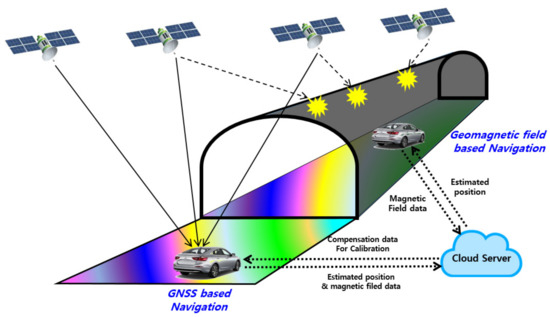
Figure 1.
Tunnel navigation using a magnetic field.
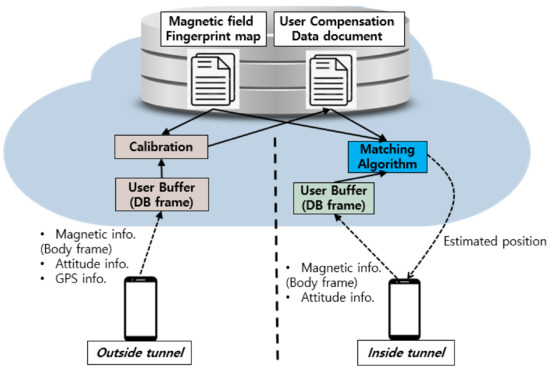
Figure 2.
Block diagram of the proposed system.
3. Proposed System Explanation
3.1. Magnetic Field in Tunnel Environment
Figure 3 depicts the test bed, which comprised three tunnels with a total length of approximately 12 km. The magnetic field values obtained for the test bed are presented in Figure 4. The magnetic field value was measured from the three axes of the magnetic sensor in the smartphone. The blue, red, and yellow lines represent the x, y, and z axis values of the magnetic sensor, respectively. The results of the repeated experiments in the space marked in Figure 4 are depicted in Figure 5. The magnetic sensor values suggested adequate repeatability, and the repeated experiments with various time periods using the same device demonstrated that the stored magnetic sensor values were similar. Figure 5a depicts that the magnetic values of all the axes fluctuated significantly. When the vehicle passes through a bridge, the fluctuation of magnetic field values occurs. There is a considerably high repeatability in such situations. The yellow ellipses in Figure 5b depict the recurrence of a specific pattern for the magnetic field values, which enables the accurate position estimation using these features. This pattern occurs when the vehicle passes by an emergency parking lot in the tunnel.
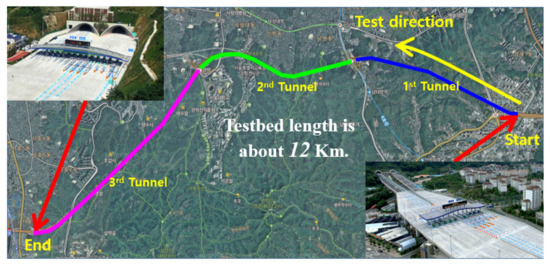
Figure 3.
Test bed for tunnel navigation experiment.
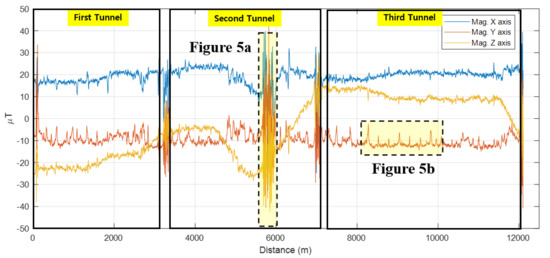
Figure 4.
Magnetic field value in the tunnel.
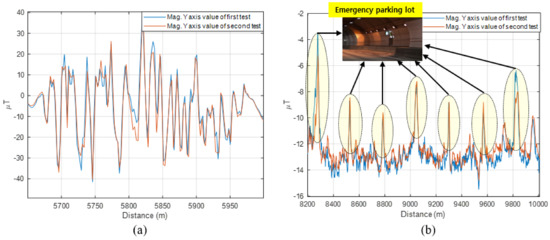
Figure 5.
Magnetic field values of repeated experiments in the tunnel. (a) high repeatability, (b) recurrence of a specific pattern.
3.2. Device Calibration
The smartphone must be calibrated for position estimation using the magnetic sensor. We created the magnetic field DB using a magnetic sensor embedded in the smartphone. The output of the magnetic sensor included various error factors such as sensor alignment error and bias, which were included for constructing the magnetic field DB. In the localization phase, the calibration was performed by assuming that the magnetic sensor value for a particular position of the smartphone was equal to that stored in the DB. The experimental results conducted in the tunnel using two independent smartphones are presented in Figure 6, which depict a similar pattern including a bias between the two values.

Figure 6.
Magnetic field values of two distinct smartphones in the tunnel.
As the vehicle position before entering the tunnel is known from the GNSS, the magnetic sensor of the user smartphone can be calibrated based on the corresponding DB value. The magnetic sensor values recorded using the two smartphones in indoor conditions are presented in Figure 7, wherein the blue and red lines represent the y axis values of the magnetic sensor of the first and second smartphones, respectively. The experimenter walked with the two smartphones side-by-side. The experimenter held two smartphones in the same direction and walked up to 1000 samples. Thereafter, the experimenter altered the attitude of the second smartphone and walked further. Up to 1000 samples, the two smartphones exhibited similar patterns due to their identical orientation. However, the absolute values of the magnetic sensors varied due to the bias of the two magnetic sensors. Subsequently, the y axis value varied as the axis of the second smartphone was altered after 1000 samples. The orange line denotes the results of altering the axis of the second smartphone with respect to the DB frame with the sensor calibration. Finally, the y axis values of the two smartphones were observed to be highly similar. Notably, the body frame of the user’s smartphone must be converted into the DB frame for accurate position estimation. When collecting the magnetic field DB, the pitch angle of the smartphone is 90 degrees, and its negative z axis is the same as the vehicle’s moving direction. In other words, the smartphone was vertically attached on the dashboard during the creation of the magnetic field DB, and this frame was defined as the DB frame. The magnetic DB is represented as follows:
where indicates the position of the fingerprint for outdoor and stands for indoor fingerprint position. denotes the magnetic field value of fingerprint DB at k-th RP outdoors. is the magnetic field value of x axis of fingerprint DB at k-th RP outdoors and is the magnetic field value of x axis of fingerprint DB at first RP in the tunnel. The fingerprint DB for outdoors is used in the calibration process of the user smartphone, and the fingerprint DB stored indoors is used for vehicle localization. In this study, we proposed a very simple calibration method and the process is as follows. The measured magnetic field value from the user smartphone can be expressed as:
where is the user position from GNSS outdoors and is the magnetic field value of the user smartphone. If is close to , we assumed that the magnetic field value of user smartphone is identical with the magnetic fingerprint DB value as:
where is the rotation matrix used to transform the body frame into the DB frame. Finally, the compensation value, , can be obtained as:

Figure 7.
Indoor magnetic field values of two different smartphones. Magnetic sensor values were corrected through frame transformation and calibration.
3.3. Generation of Magnetic Field DB
The objective of the proposed system is to determine the RP with the highest correlation by comparing the user buffer with the DB, which necessitates construction of the magnetic field DB. The interval of the DB RP was set to 5 m, considering the resolution of the magnetic field. Following the application of the smoothing filter to reduce the magnetic sensor noise, the interpolation was performed using the spline technique [23] to generate RP at intervals of 5 m. There were a total of 2341 RPs in the test bed. Although the exact vehicle position could be estimated for narrow spacing between RPs, the computational load of the calculation increases. In contrast, the resolution of the magnetic field DB decreases and the position error may increase for wide spacing between RPs.
3.4. Subsequence Dynamic Time Warping for Tunnel Environment Positioning
Dynamic time warping (DTW) is a popular algorithm for determining the optimal alignment of two time series data. DTW enables optimal alignment regardless of the varying lengths and speeds of the two sequential data. In this study, the optimal alignment signifies the minimal difference between the two selected sequences comprising the estimated pair. For a result pair estimated through DTW, the first and last indices of each pair correspond to the first and last values of the input data, respectively. However, the data measured in certain applications may be a portion of the data already stored. The sequence data X and Y to be compared are defined as follows,
where L indicates the length of X, and uL denotes the length of Y. As Y is only a fraction of X, physically, the index of Y can be evaluated as,
Subsequence DTW is an algorithm that determines the optimal pair in a given situation. In addition, the value of the first row is continuously initialized in calculating the accumulated cost matrix using subsequence DTW. The optimal pairs for DTW and subsequence DTW are depicted with a red line in Figure 8a,b, respectively. The endpoints of X and Y are the same in Figure 8a.
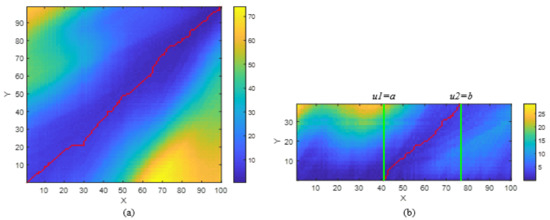
Figure 8.
Accumulated cost matrix and optimal pair for (a) dynamic time warping and (b) subsequence dynamic time warping.
On the other hand, the first index of Y (u1) matched a, and the last index of Y (uL) matched b in Figure 8b. The measured magnetic field values were stored in the user buffer to estimate the vehicle position inside the tunnel. As the data in the user buffer became a part of the DB upon comparison, the position was estimated by applying sequence DTW. However, the computational cost becomes exceedingly large upon comparing the entire DB and user data due to the storage of numerous RPs in the DB. Therefore, in this study, only a portion of the DB—defined as minor DB—was utilized for position estimation using the optimal pair result obtained earlier. The minor DB was selected by adding the RP margin index to the previous pair index. The margin index to be additionally imported was defined as R. The construction of the minor DB is illustrated in Figure 9. The red line indicates the minor DB data and its sequence can be defined as

Figure 9.
Minor DB generation using previous pair index and RP margin, R.
Finally, the result of sequence DTW can be expressed as
The final estimated position of the vehicle is the position of the RP corresponding to the b* index.
4. Experimental Results and Discussion
4.1. Test Bed
The proposed system was verified with an experiment conducted at Gangnam Beltway in Seoul, Korea. Figure 3 shows the test bed. Figure 10 presents the experimental setup, where the smartphone was attached to the dashboard using a holder. The data from the magnetic sensor of the smartphone were stored in an internal SD card at 50 Hz. In addition, the vehicle velocity data of on-board diagnostic 2 (OBD2) were stored together at approximately 2 Hz. OBD2 data are transmitted to the smartphone through USB serial communication. The sensor data and OBD2 data are simultaneously stored in the smartphone, and when data are saved, the internal clock time of the smartphone is also stored. Since the sampling time of sensor data is faster than that of OBD2 data, OBD2 data is interpolated to generate synchronized data with the sensor data. The vehicle position calculated using OBD2 velocity are utilized for DB generation and experimental verification.

Figure 10.
Experimental setup.
4.2. Test Scenarios Explanation
We have conducted four scenarios to verify the proposed system performance in the test bed. The experimental conditions are listed in Table 1. Two smartphones—Samsung Galaxy 9+ and Galaxy 20 Ultra—were used in the experiments. Galaxy 9+ was also used for DB data acquisition. As depicted in Figure 11a, the smartphone was fixed on the dash board and the experiment was conducted with the same smartphone pose in the first, third scenarios. Figure 11b shows another smartphone attitude in the rest of the scenarios. Figure 12 shows the smartphone attitude estimation results for each scenario. In the first and third scenarios, the pitch value is close to 90 degrees and the roll value is close to 0 degrees. We can also see that the pitch value in the other scenarios is approximately 60 degrees. This experiment demonstrated that a stable positioning accuracy can be obtained inside the tunnel through the proposed system, regardless of the attitude or brand model of the smartphone. Figure 13 shows the vehicle speed of all scenarios.

Table 1.
Experimental scenario settings.
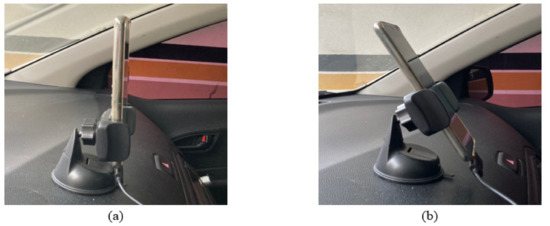
Figure 11.
Smartphone attitude of (a) first, third scenarios, (b) second, fourth scenarios.
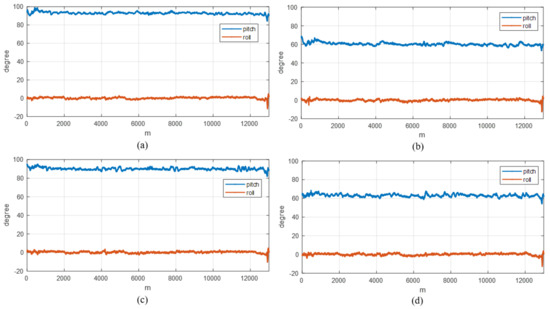
Figure 12.
Attitude estimation results of all scenarios. (a) Scenario 1. (b) Scenario 2. (c) Scenario 3. (d) Scenario 4.

Figure 13.
Vehicle speed of all scenarios. (a) Scenario 1. (b) Scenario 2. (c) Scenario 3. (d) Scenario 4.
4.3. Experimental Results
The measurements are stored at 50 Hz, but we resampled it to 5 Hz to estimate the location. Considering the speed of a typical vehicle in the tunnel and the spatial resolution of the magnetic field, it was possible to accurately estimate the vehicle’s position even using a measurement value of 5 Hz. The core objective of this study is position estimation by accumulating the magnetic sensor value for a certain period of time, and thereafter comparing it with the DB.
The magnetic field values obtained in the fourth scenario are presented in Figure 14. Blue lines represent the magnetic fingerprint DB values. Red lines in Figure 14a,c,e present the x, y, and x axes, respectively. In the fourth scenario, since the attitude of the smartphone is different from the DB frame, it can be seen that the magnetic field pattern of user data is also quite different with that of DB data like Figure 14a,c,e. Figure 14b,d,f show user magnetic field data after axis transformation and calibration. Finally, the user data patterns have been changed very similarly to the DB.

Figure 14.
User data before and after applying axes transformation and calibration for scenario 4. Blue lines and red lines indicate the magnetic fingerprint DB data and user magnetic field data, respectively. (a) Before calibration of x axis. (b) After calibration of x axis. (c) Before calibration of y axis. (d) After calibration of y axis. (e) Before calibration of z axis. (f) After calibration of z axis.
Figure 15 shows the localization error of proposed system in the entire tunnel for fourth scenario. The magnetic field data was accumulated in the user buffer for 25 s. As a result of various experiments, it was confirmed that stable results were obtained when the magnetic sensor data was accumulated for more than 15 s. Also, through the results of scenario 4, the position estimation results validated that both the axis transformation and calibration of the smartphone were conducted adequately. An analysis of the overall positioning error is presented in Table 2. Table 2 presents the mean, root mean square error (RMSE), and 90% circular error probability (CEP90). In all scenarios, a mean error of less than 10 m was obtained. It also provided a position error of 17 m or less with a 90% probability. Table 2 suggests that the proposed system can estimate the position of a vehicle very accurately. Additionally, since the four experiments were conducted at different times, the vehicles around the test vehicle were also different for each experiment. When looking at the experimental results, it can be seen that the surrounding vehicle environment does not significantly affect the magnetic field data measured by the smartphone. Figure 16 depicts the cumulative distribution function (CDF) of the results. Overall, 90% of the cases displayed an error of less than approximately 16 m. Table 3 shows the performance comparison between the existing technologies and the proposed technology. Most of the existing technologies provide accurate results compared to the proposed method, but requires the installation of infrastructure for positioning. Existing technologies are also affected by the placement and spacing between installed transmitters.
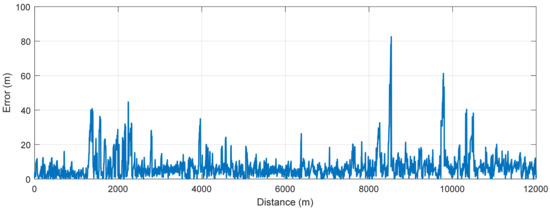
Figure 15.
Positioning result of the fourth scenario in the entire test bed.

Table 2.
Analysis of positioning error of the proposed system (Scenario 1~4).

Figure 16.
Cumulative distribution function for scenarios 1–4.

Table 3.
Performance comparison with other technologies.
The computational time for position calculation is approximately 10-ms. The experimental data were analyzed on a personal computer with an Intel Core i7-1165G7 processor. Considering the amount of computation of the proposed system, the proposed method could effortlessly estimate the position in real time.
4.4. Discussion
In this study, we demonstrated that the position of a vehicle inside a tunnel can be estimated with high accuracy using magnetic sensor readings. Unlike for pedestrians, the magnetic field could be utilized for the navigation of vehicles, because the driver attached the smartphone to the dashboard. In addition, the magnetic sensor could be calibrated as the vehicle position was known before entering the tunnel.
In future research, we plan to conduct experiments using various models of smartphones and vehicles. Moreover, the performance of the proposed system should be validated for sudden changes in its speed. When driving in a tunnel, there are various traffic situations such as traffic jams or accidents. We plan to conduct research using an accelerometer and gyroscope sensors of smartphones to estimate the accurate position even with various vehicle speed changes. Additionally, since the proposed technology is a fingerprint-based technology, if a large magnetic disturbance not stored in the magnetic fingerprint DB occurs, the performance may be degraded.
The navigation system proposed in this study is desirable for inclusion in existing navigation systems, and seamless navigation can be achieved with general navigation on the road, where the GNSS is received, and magnetic field-based positioning inside the tunnel. In order to expand the system to more tunnels, building an accurate magnetic fingerprint DB will be a very important key.
5. Conclusions
Existing navigation systems based on GNSS cannot provide accurate positions in tunnel environments. This study demonstrated that the magnetic field inside a tunnel can be used to accurately estimate the position of a vehicle inside a tunnel, where GNSS is not received. Although the magnetic field manifests high resolution and repeatability in the tunnel, the issues concerning the magnetic sensor calibration and attitude estimation of smartphones must be resolved to accurately estimate the vehicle position using magnetic field readings. After converting the frame of the user’s smartphone into the DB frame, and the magnetic sensor was calibrated based on the position before tunnel entrance and the magnetic field DB. In addition, the magnetic field values accumulated over a certain period of time were used to estimate the vehicle position. Moreover, subsequence DTW was applied to compare the user buffer data and minor DB. Consequently, the average position accuracy estimated using magnetic sensor readings accumulated for 25 s was less than 10 m in all scenarios. Thus, the proposed method could accurately estimate the exact vehicle position inside tunnels. Furthermore, drivers will be able to use seamless and stable navigation services in a tunnel environment by combining the proposed technology with existing navigation systems.
Author Contributions
All authors contributed to this research. B.S., J.-H.L., C.Y., and H.K. performed the experiment and analyzed the experimental results. B.S. drafted the manuscript. T.L. designed the proposed method. T.L. reviewed the entire manuscript. All authors have read and agreed to the published version of the manuscript.
Funding
This work was supported by the National Research Council of Science and Technology (NST) grant by the Korea government (MSIT) [CRC-20-02-KIST]. It was partly supported by the Institute for Information and Communications Technology Program (IITP) Grant funded by the Korea Government (Ministry of Science and ICT, MSIT) under Grant 2019-0-01401 and by the Multi-source based 3D Emergency LOCalization using machine learning techniques (MELOC).
Institutional Review Board Statement
Not applicable.
Informed Consent Statement
Not applicable.
Data Availability Statement
Not applicable.
Conflicts of Interest
The authors declare no conflict of interest.
References
- Realini, E.; Caldera, S.; Pertusini, L.; Sampietro, D. Precise GNSS positioning using smart devices. Sensors 2017, 17, 2434. [Google Scholar] [CrossRef] [PubMed] [Green Version]
- Shin, B.; Lee, J.H.; Yu, C.; Kim, C.; Lee, T. Underground parking lot navigation system using long-term evolution signal. Sensors 2021, 21, 1725. [Google Scholar] [CrossRef] [PubMed]
- Li, N.; Gao, Y.; Wang, Y.; Liu, Z.; Guan, L.; Liu, X. A low-cost underground garage navigation switching algorithm based on kalman filtering. Sensors 2019, 19, 1861. [Google Scholar] [CrossRef] [PubMed] [Green Version]
- Guo, X.; Ansari, N.; Hu, F.; Shao, Y.; Elikplim, N.R.; Li, L. A survey on fusion-based indoor positioning. IEEE Commun. Surv. Tutorials 2020, 22, 566–594. [Google Scholar] [CrossRef]
- Guo, G.; Chen, R.; Ye, F.; Peng, X.; Liu, Z.; Pan, Y. Indoor Smartphone Localization: A Hybrid WiFi RTT-RSS Ranging Approach. IEEE Access 2019, 7, 176767–176781. [Google Scholar] [CrossRef]
- Shin, B.; Lee, J.H.; Lee, T.; Kim, H.S. Enhanced weighted K-nearest neighbor algorithm for indoor Wi-Fi positioning systems. In Proceedings of the 2012 8th International Conference on Computing Technology and Information Management (NCM and ICNIT), Seoul, Korea, 24–26 April 2012; Volume 2, pp. 574–577. [Google Scholar] [CrossRef]
- Monfared, S.; Nguyen, T.H.; Petrillo, L.; De Doncker, P.; Horlin, F. Experimental Demonstration of BLE Transmitter Positioning Based on AOA Estimation. In Proceedings of the 2018 IEEE 29th Annual International Symposium on Personal, Indoor and Mobile Radio Communications (PIMRC), Bologna, Italy, 9–12 September 2018; pp. 856–859. [Google Scholar] [CrossRef] [Green Version]
- Subbu, K.P.; Gozick, B.; Dantu, R. LocateMe: Magnetic-fields-based indoor localization using smartphones. ACM Trans. Intell. Syst. Technol. 2013, 4, 1–27. [Google Scholar] [CrossRef]
- Alarifi, A.; Al-Salman, A.; Alsaleh, M.; Alnafessah, A.; Al-Hadhrami, S.; Al-Ammar, M.A.; Al-Khalifa, H.S. Ultra wideband indoor positioning technologies: Analysis and recent advances. Sensors 2016, 16, 707. [Google Scholar] [CrossRef] [PubMed]
- Bisio, I.; Lavagetto, F.; Marchese, M.; Sciarrone, A. Smart probabilistic fingerprinting for WiFi-based indoor positioning with mobile devices. Pervasive Mob. Comput. 2016, 31, 107–123. [Google Scholar] [CrossRef]
- Cypriani, M.; Delisle, G.; Hakem, N. Wi-Fi-based positioning in underground mine tunnels. In Proceedings of the International Conference on Indoor Positioning and Indoor Navigation, Montbeliard, France, 28–31 October 2013; pp. 28–31. [Google Scholar] [CrossRef]
- Qin, Y.; Zhou, C.; Yang, S.H.; Wang, F. A distributed newton iteration based localization scheme in underground tunnels. In Proceedings of the 2012 UKACC International Conference on Control, Cardiff, UK, 3–5 September 2012; pp. 851–856. [Google Scholar] [CrossRef]
- Song, X.; Li, X.; Tang, W.; Zhang, W.; Li, B. A hybrid positioning strategy for vehicles in a tunnel based on rfid and in-vehicle sensors. Sensors 2014, 14, 23095–23118. [Google Scholar] [CrossRef] [PubMed] [Green Version]
- Islam, A.; Hossain, M.A.; Le, N.T.; Hong, C.H. Precise Localization in Tunnel Environment using Visible Light Communication. In Proceedings of the 26th Joint Conference on Communications and Information, Lisbon, Portugal, 26–28 July 2016. [Google Scholar]
- Kim, B.W.; Jung, S.Y. Vehicle positioning scheme using V2V and V2I visible light communications. In Proceedings of the 2016 IEEE 83rd Vehicular Technology Conference (VTC Spring), Nanjing, China, 15–18 May 2016; pp. 1–5. [Google Scholar] [CrossRef]
- Li, C.R.; Xie, J.L.; Yang, L.L. Angle offset-assisted positioning of railway vehicles in tunnel environments. In Proceedings of the 2015 IEEE 81st Vehicular Technology Conference (VTC Spring), Glasgow, UK, 11–14 May 2015. [Google Scholar] [CrossRef]
- Li, B.; Gallagher, T.; Dempster, A.G.; Rizos, C. How feasible is the use of magnetic field alone for indoor positioning? In Proceedings of the 2012 International Conference on Indoor Positioning and Indoor Navigation (IPIN), Sydney, Australia, 13–15 November 2012. [Google Scholar] [CrossRef]
- Galván-Tejada, C.E.; Zanella-Calzada, L.A.; García-Domínguez, A.; Magallanes-Quintanar, R.; Luna-García, H.; Celaya-Padilla, J.M.; Galván-Tejada, J.I.; Vélez-Rodríguez, A.; Gamboa-Rosales, H. Estimation of Indoor Location Through Magnetic Field Data: An Approach Based on Convolutional Neural Networks. ISPRS Int. J. Geo-Inf. 2020, 9, 226. [Google Scholar] [CrossRef] [Green Version]
- Galván-Tejada, C.E.; García-Vázquez, J.P.; Brena, R.F. Magnetic field feature extraction and selection for indoor location estimation. Sensors 2014, 14, 11001–11015. [Google Scholar] [CrossRef] [PubMed] [Green Version]
- Al-homayani, F.; Mahoor, M. Improved indoor geomagnetic field fingerprinting for smartwatch localization using deep learning. In Proceedings of the 2018 IEEE International Conference on Indoor Positioning and Indoor Navigation (IPIN), Nantes, France, 24–27 September 2018; pp. 1–8. [Google Scholar]
- Xie, H.; Gu, T.; Tao, X.; Ye, H.; Lv, J. MaLoc: A practical magnetic fingerprinting approach to indoor localization using smartphones. In Proceedings of the 2014 ACM International Joint Conference on Pervasive and Ubiquitous Computing, Seattle, WA, USA, 13–17 September 2014. [Google Scholar] [CrossRef]
- Müller, M. Information Retrieval for Music and Motion; Springer: Berlin/Heidelberg, Germany, 2007; ISBN 9783540740476. [Google Scholar]
- Stout, T.A.; Sparrow, V.W. Time-domain spline interpolation in a simulation of N-wave propagation through turbulence. J. Acoust. Soc. Am. 2018, 229, EL229–EL235. [Google Scholar] [CrossRef] [PubMed] [Green Version]
Publisher’s Note: MDPI stays neutral with regard to jurisdictional claims in published maps and institutional affiliations. |
© 2021 by the authors. Licensee MDPI, Basel, Switzerland. This article is an open access article distributed under the terms and conditions of the Creative Commons Attribution (CC BY) license (https://creativecommons.org/licenses/by/4.0/).